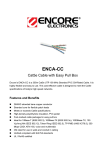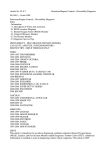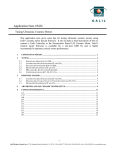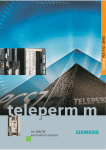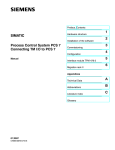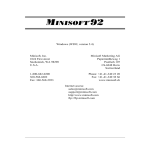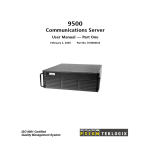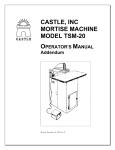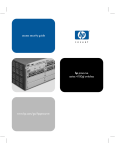Download HP 100VG-ANYLAN B5426-90001 User's Manual
Transcript
HP-PB 100VG-AnyLAN Network Adapter Installation and Service HP 3000 MPE/iX Computer Systems Edition 1 B5426-90001 E0897 Printed in: U.S.A. August 1997 Notice The information contained in this document is subject to change without notice. Hewlett-Packard makes no warranty of any kind with regard to this material, including, but not limited to, the implied warranties of merchantability or fitness for a particular purpose. Hewlett-Packard shall not be liable for errors contained herein or for direct, indirect, special, incidental or consequential damages in connection with the furnishing or use of this material. Hewlett-Packard assumes no responsibility for the use or reliability of its software on equipment that is not furnished by Hewlett-Packard. This document contains proprietary information which is protected by copyright. All rights reserved. Reproduction, adaptation, or translation without prior written permission is prohibited, except as allowed under the copyright laws. Restricted Rights Legend Use, duplication, or disclosure by the U.S. Government is subject to restrictions as set forth in subparagraph (c) (1) (ii) of the Rights in Technical Data and Computer Software clause at DFARS 252.227-7013. Rights for non-DOD U.S. Government Departments and Agencies are as set forth in FAR 52.227-19 (c) (1,2). Hewlett-Packard Company 3000 Hanover Street Palo Alto, CA 94304 U.S.A. © Copyright 1997 by Hewlett-Packard Company 2 Contents HP-PB 100VG-AnyLAN Network Adapter Installation at a Glance 9 Installation Overview . . . . . . . . . . . . . . . . . . . . . . . . . . . . . . . . . . . . . . . .10 Product Description . . . . . . . . . . . . . . . . . . . . . . . . . . . . . . . . . . . . . . . .10 Product Contents . . . . . . . . . . . . . . . . . . . . . . . . . . . . . . . . . . . . . . . . . .10 Tools and Accessories . . . . . . . . . . . . . . . . . . . . . . . . . . . . . . . . . . . . . . .10 In This Book. . . . . . . . . . . . . . . . . . . . . . . . . . . . . . . . . . . . . . . . . . . . . . . .11 1. Installation Procedure 1. Prepare to Install the Adapter . . . . . . . . . . . . . . . . . . . . . . . . . . . . . . .14 Observe Antistatic Precautions . . . . . . . . . . . . . . . . . . . . . . . . . . . . . . .14 Verify Product Contents . . . . . . . . . . . . . . . . . . . . . . . . . . . . . . . . . . . . .14 Record Adapter Information . . . . . . . . . . . . . . . . . . . . . . . . . . . . . . . . .15 Gather Tools and Accessories . . . . . . . . . . . . . . . . . . . . . . . . . . . . . . . .16 2. Shut Down the Operating System and Switch Off the Computer . . .17 3. Install the Adapter . . . . . . . . . . . . . . . . . . . . . . . . . . . . . . . . . . . . . . . .18 a. Access the adapter slot(s). . . . . . . . . . . . . . . . . . . . . . . . . . . . . . . . . .18 b. Select an available slot. . . . . . . . . . . . . . . . . . . . . . . . . . . . . . . . . . . .18 c. Insert the adapter into the slot . . . . . . . . . . . . . . . . . . . . . . . . . . . . .18 d. Switch on the power to the computer. . . . . . . . . . . . . . . . . . . . . . . . .19 4. Attach the Adapter to the Network . . . . . . . . . . . . . . . . . . . . . . . . . . .20 5. Configure the Adapter into the System . . . . . . . . . . . . . . . . . . . . . . . .21 6. Verify Operation . . . . . . . . . . . . . . . . . . . . . . . . . . . . . . . . . . . . . . . . . .22 2. Service Information Field Replaceable Units . . . . . . . . . . . . . . . . . . . . . . . . . . . . . . . . . . . . . .24 Exchange Assembly . . . . . . . . . . . . . . . . . . . . . . . . . . . . . . . . . . . . . . . .24 Troubleshooting Tools . . . . . . . . . . . . . . . . . . . . . . . . . . . . . . . . . . . . . . . .25 Card LEDs . . . . . . . . . . . . . . . . . . . . . . . . . . . . . . . . . . . . . . . . . . . . . . .25 3 Contents Removal/Replacement Instructions. . . . . . . . . . . . . . . . . . . . . . . . . . . . . 27 Removal/Replacement of the Adapter . . . . . . . . . . . . . . . . . . . . . . . . . 28 Reshipment Guidelines . . . . . . . . . . . . . . . . . . . . . . . . . . . . . . . . . . . . . . 29 Technical Specifications . . . . . . . . . . . . . . . . . . . . . . . . . . . . . . . . . . . . . . 30 Declaration of Conformity . . . . . . . . . . . . . . . . . . . . . . . . . . . . . . . . . . . . 31 Glossary 4 Figures Figure 1-1 . Address Location . . . . . . . . . . . . . . . . . . . . . . . . . . . . . . . . . .15 Figure 1-2 . Inserting and Securing Adapter . . . . . . . . . . . . . . . . . . . . . .19 Figure 1-3 . Port Connection . . . . . . . . . . . . . . . . . . . . . . . . . . . . . . . . . . .20 Figure 2-1 . Declaration of Conformity. . . . . . . . . . . . . . . . . . . . . . . . . . .31 5 Figures 6 Tables Table 1-1. LED Patterns . . . . . . . . . . . . . . . . . . . . . . . . . . . . . . . . . . . . . .22 Table 2-1. Troubleshooting Checklist . . . . . . . . . . . . . . . . . . . . . . . . . . . .26 Table 2-2. 100VG Network Adapter Technical Specifications. . . . . . . . .30 7 Tables 8 HP-PB 100VG-AnyLAN Network Adapter Installation at a Glance The following figure shows how to install the HP-PB 100VG-AnyLAN Network Adapter. 9 Installation Overview The installation procedure includes the following major steps: 1. Prepare to install the adapter. 2. Shut down the operating system and switch off the power to the computer. 3. Install the adapter. 4. Attach the adapter to the network. 5. Configure the adapter. 6. Verify operation. Product Description The HP-PB 100VG-AnyLAN Network Adapter provides the hardware needed to interface an HP-PB backplane to a 100VG-AnyLAN Network. The HP-PB 100VG-AnyLAN Network Adapter has the following features: • one built-in connector: an RJ-45 connector, for attachment to the hub • 10 or 100-Mbit per second operation • single-high form factor Product Contents • HP-PB 100VG-AnyLAN Network Adapter — A3496-60001 • Installation and Service Manual — B5426-90001 Tools and Accessories Before installation, gather these tools and accessories: • screwdrivers necessary for opening your computer and installing adapters • grounding wrist strap • cable for attachment to hub, UTP category 3 or 5 10 In This Book This book is the installation and service manual for the HP-PB 100VG-AnyLAN Network Adapter that connects an HP 3000 computer using the HP-PB backplane to a 100VG-AnyLAN network. The installation procedure section contains the installation instructions. It explains in detail the steps necessary to install the adapter into your computer. The service information section defines the steps and procedures to follow if you experience trouble with the adapter. It explains diagnostics to be used for troubleshooting, removal/replacement instructions, reshipment guidelines, and technical specifications. NOTE This manual is limited to installation of the HP-PB 100VG-AnyLAN Network Adapter only. It is assumed network hubs and cabling are in place and the appropriate HP-PB 100VG-AnyLAN network software and operating system have already been installed on the computer. 11 12 1 Installation Procedure This section contains installation instructions for the HP-PB 100VG-AnyLAN Network Adapter. The instructions are organized into six primary steps listed below. Each step is described in detail in this section. If the adapter has already been installed at the factory, you may proceed directly to step 4. 1. Prepare to install the adapter. 2. Shut down the operating system and switch off the computer. 3. Install the adapter. 4. Attach the adapter to the network. 5. Configure the adapter into the system. 6. Verify operation. 13 Installation Procedure 1. Prepare to Install the Adapter 1. Prepare to Install the Adapter Before installing the adapter, you should perform the following steps: 1. Observe antistatic precautions. 2. Verify product contents. 3. Record adapter identification information. 4. Gather tools and accessories. Observe Antistatic Precautions This product contains electronic components that can easily be damaged by small amounts of static electricity. To avoid damage, follow these guidelines: • Store adapters in their conductive plastic bags until you are ready to install them. • If possible, work in a static-free area. • Handle adapters only by the edges. Do not touch electronic components or electrical traces. We strongly recommend that you use a grounding wrist strap that is connected to the metallic chassis of the computer. If you do not have a wrist strap, touch the chassis before handling adapters, and frequently or continuously thereafter, to equalize any static charge. Verify Product Contents Unpack and identify all items supplied with the products: Part Numbers • HP-PB 100VG-AnyLAN Network Adapter A3496-60001 • Installation and Service Manual B5426-90001 14 Chapter 1 Installation Procedure 1. Prepare to Install the Adapter Record Adapter Information Record the relevant information from the card here for future reference. If your adapter requires service in the future this information will be needed by HP service personnel. Card Information Example Motherboard Model and Revision number __________________ H05000-003, REVB02 Daughter Card Model and Revision number __________________ H04522-001, REVC00 Daughter Card Serial number __________________ 615385 Daughter Card Station Address __________________ 0060B0D52EFC Information to Record This information is provided on stickers affixed to various locations on the adapter cards. Use Figure 1-1, for the locations of the relevant information. Figure 1-1 Address Location Chapter 1 15 Installation Procedure 1. Prepare to Install the Adapter Gather Tools and Accessories Check the hardware installation manual of your computer model for special tools and accessories required to access the I/O adapter slot(s). The following common tools are helpful: • screwdrivers necessary for opening your computer and installing adapters • grounding wrist strap NOTE You should have all of your system and peripheral device manuals available for reference. There may be special system or device dependent requirements that are not noted here. 16 Chapter 1 Installation Procedure 2. Shut Down the Operating System and Switch Off the Computer 2. Shut Down the Operating System and Switch Off the Computer 1. Before installing the HP-PB 100VG-AnyLAN Network Adapter, ensure that the operating system is shut down. Refer to your computer system manuals for proper shutdown procedures to avoid corruption or loss of data. 2. Ensure that power to the host computer is switched off and disconnected from the source power supply. WARNING Unless otherwise noted in your computer system manuals, failure to properly shut down the system and remove power may create a personnel hazard, or may result in hardware damage or data corruption. Chapter 1 17 Installation Procedure 3. Install the Adapter 3. Install the Adapter To install the adapter in the host computer, perform the following steps: a. Access the adapter slot(s). b. Select an available adapter slot. c. Insert the adapter into the slot. d. Switch on the power to the computer. a. Access the adapter slot(s) Because computer models vary, there may be different procedures to access and select an adapter slot. Before you install the adapter, you should refer to the manuals that apply to your particular computer for instructions. Identify the following information: • authorized or recommended adapter configurations and limitations, if any • how to access the computer’s adapter slot(s) • proper orientation of the adapter in its slot b. Select an available slot Select an available HP-PB adapter slot. Remove the slot cover for that slot. Refer to your computer system administrator’s documentation. Retain the cover for possible future use. Verify you can see an adapter connector at the back of the slot. Record the slot number for future reference. If there are no other adapters to install, reassemble the computer. c. Insert the adapter into the slot Insert the adapter into the adapter slot connector and press in firmly until the adapter is fully seated into the connector. Refer to Figure 1-2. 1. With both hands, grasp the adapter by its edges or faceplate. Do not touch electronic components or electrical traces. 18 Chapter 1 Installation Procedure 3. Install the Adapter 2. Insert the adapter into the slot. Be sure the contacts and adapter guides are properly aligned. 3. Fold in the extractor levers. 4. Press the adapter firmly until you feel the connector mate fully. 5. Secure the adapter in its slot by securing the retaining screws. Figure 1-2 Inserting and Securing Adapter d. Switch on the power to the computer. 1. Reconnect the source power supply to the computer. 2. Switch on the computer power switch. Chapter 1 19 Installation Procedure 4. Attach the Adapter to the Network 4. Attach the Adapter to the Network Use the RJ-45 connector for connecting a UTP category 3 or 5 cable (not supplied) to a 100VG-AnyLAN hub or 10Base-T hub/switch. Refer to Figure 1-3.. Figure 1-3 Port Connection Attach the cable to the RJ-45 connector by following these steps: a. Plug the cable into the RJ-45 connector. b. Secure the other end of the cable to the 100VG-AnyLAN hub or 10Base-T hub/switch. c. If necessary, reconfigure the hub/switch port to operate at the desired speed and duplex settings. NOTE All of the LEDs on the adapter (except the Power LED) are initialized by software when the link is started on the system. Therefore, until software initializes the adapter, the state of the LEDs cannot be reliably interpreted. 20 Chapter 1 Installation Procedure 5. Configure the Adapter into the System 5. Configure the Adapter into the System On MPE systems you will need to configure the adapter into the system. In particular you must specify link speed and duplex settings to match those of the network hub/switch port to which you attached the adapter. For more information on MPE systems, refer to: • NS3000/iX NMMGR Screens Reference Manual (36922-61003) • HP3000/iX Network Planning and Configuration Guide (36922-61023) • System Startup, Configuration, and Shutdown Reference Manual (32650-90042) Chapter 1 21 Installation Procedure 6. Verify Operation 6. Verify Operation Verify proper operation of the HP-PB 100VG-AnyLAN Network Adapter by checking the LEDs on the card. When the computer is switched on, the Power LED will come on. At this point, the rest of the LEDs are in an uninitialized state, and cannot be used until the driver on the system has been started. After the driver has been started, the following Table 1-1, may be used to interpret the LED patterns. Table 1-1 LED Patterns LED LED on LED off Test Driver has detected a fatal condition and is no longer operating. Adapter is functioning correctly. 10 Adapter is operating at 10Mbps. Adapter is not operating at 10Mbps. 100 Adapter is operating at 100Mbps. Adapter is not operating at 100Mbps. Link Adapter is correctly receiving a link signal from the hub/switch. Adapter is not receiving a link signal from the hub/switch. Activity Adapter is sending or receiving a packet to/from the hub/switch. No packet is currently being transferred to/from the hub/switch. Power Adapter is receiving power from the system. The system is not supplying power, or the adapter is not seated properly in the slot. 22 Chapter 1 2 Service Information This section provides the following service information: • Field Replaceable Units • Troubleshooting Tools • Removal/Replacement Instructions • Reshipment Guidelines • Technical Specifications 23 Service Information Field Replaceable Units Field Replaceable Units Field Replaceable Units (FRUs) are assemblies or components that are authorized for field replacement. There are no FRUs on this adapter. If there should be a problem the entire adapter is replaceable. Exchange Assembly The HP-PB 100VG-AnyLAN Network Adapter may be replaced under the HP board exchange program. Adapter part numbers are listed below: 24 New Adapter A3496-60001 Exchange Adapter A3496-69001 Chapter 2 Service Information Troubleshooting Tools Troubleshooting Tools Troubleshooting tools are used to identify faulty adapters. For this product, the following tools are available: • troubleshooting checklist (see Table 2-1) • VGPBA online diagnostic (has online help) Card LEDs The 6 LEDs on the back of the card can be used to determine the state of the adapter while the driver on the system is running. NOTE All of the LEDs on the card (except the Power LED) are initialized by the driver when the link is started on the system. Therefore, until the driver initializes the card, the state of the LEDs cannot be reliably interpreted. The Power LED will be on at any time power is applied to the system. To interpret the other LEDs, the driver must be running. The following Table 2-1, can be used to determine a possible problem. Chapter 2 25 Service Information Troubleshooting Tools Table 2-1 Troubleshooting Checklist LED state Power LED off Possible cause Solution No power applied to card Check power to HP-PB bus/system, verify adapter is properly seated in its slot. Blown fuse Replace the adapter Test LED on Driver has detected a fatal hardware or software condition Consult console and/or log files for error messages. Retry the operation. If necessary, contact HP or replace the adapter. Link LED off Card is not receiving link signals from hub/switch Verify link has been started by the operator. If so, verify proper configuration of the link and the hub/switch port. Check/replace the cable. Activity LED off Card is not sending or receiving data to/from the hub/switch This condition is normal when the link LED is off or when the hub is not sending or receiving data to/from the adapter. If you believe data is being sent/received, check the hub/switch port configuration, and also the network and/or MAC address configuration for the link. 26 Chapter 2 Service Information Removal/Replacement Instructions Removal/Replacement Instructions This section describes removal and replacement for the HP-PB 100VG-AnyLAN Network Adapter. WARNING Unless otherwise noted in your system manuals, removal of the network adapter should only be done with power removed from the host computer. Failure to comply may result in an electrical shock hazard, or in damage to the hardware. CAUTION The adapter contains electronic components that can be damaged by static electricity. To avoid damage, follow these guidelines: • Store adapters in their conductive plastic bags. • If possible, work in a static-free area. • Handle adapters only by the edges. Do not touch electronic components or electrical traces. We strongly recommend that you use a grounding wrist strap that is connected to the metallic chassis of the computer. If you do not have a wrist strap, touch the chassis before handling adapters, and frequently or continuously thereafter, to equalize any static charge. Chapter 2 27 Service Information Removal/Replacement Instructions Removal/Replacement of the Adapter For adapter removal, follow the procedures below: 1. Before removing the card, ensure that the operating system is shut down and power to the host computer is switched off. Consult your computer documentation for proper shutdown procedures to avoid file corruption or loss of data. 2. Disconnect all cabling from the adapter. 3. Consult your computer documentation for instructions on the best method for accessing the adapter slots. 4. Unscrew the two retaining screws and pull extractor levers out. 5. While holding extractor levers, slide the adapter out of its slot. 6. Place adapter in an antistatic bag. 7. Install a slot cover for proper cooling and RFI suppression. To install a replacement adapter, follow the procedures described in the installation section. 28 Chapter 2 Service Information Reshipment Guidelines Reshipment Guidelines If any item of the product is to be returned to Hewlett-Packard for any reason, contact your HP Sales and Support Office to coordinate the return. When returning the item, attach a tag that identifies the owner and indicates the reason for shipment. Include all relevant information, which includes model, serial, station, and revision numbers. Pack the item in the original factory packaging material if available, or a suitable substitute. Provide antistatic protection to applicable components or assemblies. Chapter 2 29 Service Information Technical Specifications Technical Specifications The network adapter technical specifications are provided in Table 2-2. Table 2-2 Specifications 100VG Network Adapter Technical Specifications Safety • UL 1950, 2nd Edition • CSA 22.2 No 950, 2nd Edition • IEC 950 (1991)/EN 60950 (1992) Communication Standards • IEEE 802.12 (1995) 100 Mb/s Ethernet framing Immunity Standards • ESD: IEC 801-2: 1991 4kV CD, 8 kV AD • IEEE 802.3 Type 10Base-T 10 Mb/s • Radiated Immunity: IEC 801-3: 10 V/m • EFT/Burst: IEC 801-4: (1988) 0.5 kV signal lines, 1.0 kV power line Electrical Characteristics: 3.30 A @ 5 V typical; 3.40 A @ 5 V maximum Physical Dimensions: 18 cm. by 8.9 cm. (7.4 in. by 3.5 in.) Weight: 290 g. (10.2 oz.) Temperature Operating: 0˚C (32˚ F) to 55˚C (131˚F) Environmental Storage: -40˚C (-40˚F) to 70˚C (158˚F) Humidity Operating: 15% to 80% Relative, non-condensing Storage: 5% to 95% Relative, non-condensing Altitude: Operating: 3,050 meters (10,000 feet) Storage: 4,600 meters (15,000 feet) Emissions Standards: • FCC Class A • CISPR 22 (1993) Class A • VCCI Class A 30 Chapter 2 Service Information Declaration of Conformity Declaration of Conformity A declalaration of conformity is shown in . Figure 2-1 Declaration of Conformity Chapter 2 31 Service Information Declaration of Conformity 32 Chapter 2 Glossary Numbers C 100VG-AnyLAN Refers to the 100Mbit/s network technology over voice grade cable that is compatible with the IEEE 802.12 standard. This technology guarantees access to any end node that request to transmit, which ensuring priority access to end nodes that require consistent, continuous access for application such as full-motion video or video conferencing. See also: Demand Priority Protocol. CAT Category A cable quality rating. 100VG-AnyLAN supports CAT-3 or 5 UTP cable. See LAN cable. A adapter An add-on computer interface card and circuitry that provides the physical connection and data translation between the host computers’s I/O bus and external devices or networks. adapter slot The location where adapters attach to the backplane. B backplane For an I/O bus. The computer’s circuitry and connectors to which adapter cards connect. Glossary collision The result of two or more nodes on an 802.3 network transmitting at the same time, producing a garbled transmission. D Demand Priority Protocol A request-based protocol that is deterministic—a network end node connected to a 100VG hub makes a request (or “demand”) to transmit, and then can transmit only when authorized by the hub. Under hub control, the Demand Priority Protocol guarantees network access for any end node that requests to transmit data. driver A portion of system code that allows communication between the operating system and the network card. E Ethernet A LAN that uses the CSMA/CD method of access and transmits at 10Mbit/s on a bus or 33 Glossary star topology. The IEEE 802.3 standard evolved from Ethernet, but they are not exactly the same. Network devices based on both standards can co-exist on the same medium, but they cannot exchange data directly without special “bilingual” software that can decode packets of both types. The drivers for the HP3000 network cards fit this requirement if configured correctly. Ethernet address See station address. H HP-PB HP Precision Bus. Refers to the hardware I/O architecture. The precision bus is the bus thru which these cards communicate with the CPU and memory. Ethernet, but the two networks are not fully compatible with each other. IEEE 802.5 standard Part of the institute of Electrical and Electronics Engineers 802 family of LAN standards. The 802.5 standard defines the physical layer (layer 1) and the Medium Access Control (MAC) portion of the data link layer (layer 2). Used with Token Ring networks. IEEE 802.12 standard Part of the institute of Electrical and Electronics Engineers 802 family of LAN standards. The 802.12 standard defines the physical layer (layer 1) and the Medium Access Control (MAC) portion of the data link layer (layer 2). L I LAN See local area network. IEEE 802.3 standard Part of the institute of Electrical and Electronics Engineers 802 family of LAN standards. The 802.3 standard defines the physical layer (layer 1) and the Medium Access Control (MAC) portion of the data link layer (layer 2). The IEEE 802.3 standard evolved from 34 LAN cable The medium through which data moves in a LAN, LAN cables come in many types. For example, thick (10 mm) coaxial cable, thin (5 mm) coaxial cable, fiber-optic cable, and shielded or unshielded twisted-pair cable. The 100VG-AnyLAN cables are typically UTP CAT-3 or CAT-5. Glossary Glossary LED See light emitting diode. light emitting diode A small light on a device that is often used to provide status information. link beat A periodic signal transmitted in Ethernet and IEEE 802.3 Type 10Base-T networks to inform one station of device of the presence of another. It also helps verify the integrity of the network link between them. (Also called “link test pulse”.) local area network A generalpurpose communications network that interconnects a variety of devices within a limited geographical area. A LAN might connect computers on adjacent desks, within a building, or within several buildings of a campus. M MAC address See station address. Mbits/ Megabits per second defined as (1,000,000 bits per second). cables (fiber-optic or copper), although radio and other broadcast media are possible. N node A station; a physical device that allows for the transmission of data within a network. P packet A bit stream consisting of predefined fields that contain data, addresses, and control information. In the IEEE 802.3 environment this structure is often referred to as the ‘MAC frame”. Packet is the more commonly used term, and originated in the Ethernet environment. Precision Bus See HP-PB. protocol The set of rules governing the operation of functional units of a communication system that must be followed if communication is to be achieved. medium, media The transmission connection between nodes. Most current LANs use Glossary 35 Glossary R ring network A network configuration where a series of attaching devices are connected by unidirectional links to form a closed path. ring topology A logically circular, unidirectional transmission path without defined ends. Control can be distributed or centralized. See topology. RJ-45 A standard defining the pin assignments for an 8-pin modular plug for 4-pair twisted wire network cable. S slot The physical place in the back of the computer where a card plugs in. Each slot has a number. star topology A logically starshaped network layout where all traffic is passed through a single point (usually a hub). Hubs can then be connected to form multiple starts. Station address A 12-digit hexadecimal number that identifies a specific network node, and allows messages to be directed 36 to that node only. The first 6 digits are the same for all cards from a particular manufacturer. Each manufacturer is assigned a different 6-digit value. Then each card produced by that manufacturer has a different last 6 digits. This ensures that all cards from all manufacturers have a unique station address. HP manufactures cards with the first 6 digits being 080009 or 0060B0. A default value is permanently coded into each card, but this default can be overridden by the configuration. T token ring A network with a ring topology that uses a token for the purpose of establishing control. Control of the network is passed with the token from one network device to another. topology Topology can be physical or logical. Physical topology is the configuration of network nodes and links; a description of the physical geometric arrangement of the links and nodes. Logical topology is a description of the possible logical connections between network nodes indicating which pairs of nodes are able to communicate whether or not they have a direct physical connection. Glossary Glossary U UTP Unshielded Twisted Pair. See LAN cable. V VG See 100VG-AnyLAN. Glossary 37 Glossary 38 Glossary Index Numerics 100VG-AnyLAN hub, 20 10Base-T hub/switch, 20 G grounding wrist strap, 10, 14, 16, 27 A adapter configurations and limitations, 18 adapter part numbers, 24 adapter slot connector, 18 antistatic precautions, 14, 27, 28 attach adapter to network, 20 H HP-PB 100VG-AnyLAN Network Adapter, 10 HP-PB backplane, 10 hub/switch, 20, 21, 22, 26 B backplane, 10 before installing, 14, 17 before removing, 28 C category 3 or 5 cable, 20 configurations and limitations, 18 configure adapter to system, 21 D daughter card model and revision number, 15 declaration of conformity, 31 E exchange assembly, 24 extractor levers, 19 I inserting and securing adapter, 18 install the adapter, 9, 10, 13, 14, 18 L LAN HP-PB 100VG-AnyLAN Network Adapter Local Area Network, 10 LED patterns, 22 LEDs, 20, 22, 25, 26 R removal/replacement of adapter, 28 reshipment guidelines, 23, 29 retaining screws, 19 RFI suppression, 28 RJ-45 connector, 10, 20 S select adapter slot, 18 serial number, 15 service information, 23 shutdown procedures, 17, 28 station address, 15 storage of adapters, 27, 30 switch/hub, 20, 21, 22, 26 T technical specifications, 23, 30 tools and accessories, 10, 16 troubleshooting, 23, 25, 26 V verify operation, 22 M MAC address, 15, 26 motherboard model and revision number, 15 MPE systems, 21 N network connecton to, 20 F faulty adapters, 25 Field Replaceable Units, 23, 24 FRU Field Replaceable Units, 23 FRUs, 24 Index P part numbers, 14, 24 port connection, 20 product contents, 10, 14 product description, 10 product numbers, 14, 24 39







































